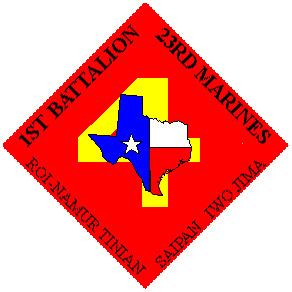Active Early 1940s Branch USMC Size 1000 | Country United States Type Infantry Battalion | |
 | ||
Role Locate, close with and destroy the enemy with fire and maneuver | ||
1st Battalion, 23rd Marines (1/23) is one of 36 infantry battalions in the United States Marine Corps, and one of only nine battalions found in the reserve. It is located throughout Texas and Louisiana consisting of approximately 1000 Marines and Sailors. They fall under the command of the 23rd Marine Regiment and the 4th Marine Division.
Contents
Mission
Provide trained combat and combat support personnel, and units to augment and reinforce the active component in time of war, national emergency, and at other times as national security requires; and have the capability to reconstitute the Division, if required.
World War II
The battalion was activated on November 20, 1942, at Marine Corps Base Camp Pendleton, California.
Gulf War
The battalion was mobilized for the first time since World War II in January 1991 in support of Operation Desert Shield. The unit was deployed to Marine Corps Base Camp Pendleton, California, in support of the 1st Marine Division during this time.
Global War on Terror
Operation Enduring Freedom(January 2002-January 2003) Elements of the battalion were activated after the September 11th attacks. Bravo Company and attachments from Alpha Company's Weapons platoon were deployed to Guantanamo Bay, Cuba, where they provided perimeter security for the base.
Operation Iraqi Freedom (June 2004) The battalion was again mobilized in June 2004 to conduct three months of pre-deployment training at the Marine Corps Air Ground Combat Center Twentynine Palms, California, in preparation for their upcoming deployment in support of Operation Iraqi Freedom. The battalion arrived in Iraq, relieving 2nd Battalion, 7th Marines in late August 2004. They augmented the 7th Marine Regiment, helping to secure the area spanning the Hit-Haditha corridor, west of Ramadi, out to the Syrian border of the Al Anbar Province. Initial assignments for the battalion's companies in Iraq saw assignments in Ar-Rutbah, Al Asad Airbase and Hit. The battalion returned from Iraq in late March 2005, having been relieved by 3rd Battalion, 25th Marines.
In May 2007, Marines that had not participated in the June 2004 mobilization were tasked to support 3rd Battalion, 23rd Marines in their upcoming activation. Volunteers from the first mobilization were also part of this support. These Marines were deployed back to the Al Anbar Province and conducted operations near and around the Haditha Dam.
Operation Enduring Freedom (Afghanistan) (November 2010 - December 2011)
About 800 Marines and Navy Corpsmen departed in November 2010 for pre-deployment training at Camp Pendleton in California. The 1/23 Marines deployed in March 2011 in support of II Marine Expeditionary Force in southwestern Afghanistan. The battalion mobilized for about 400 days, with seven months spent in Afghanistan. Alpha Company supported Regimental Combat Team 8 in the upper Sangin Valley and then transitioned to its own battle space in and around Camp Delaram II in the northwest part of Helmand province. Alpha Company also led a mission that confiscated more than 150 tons of poppy seed, marking the largest drug seizure by NATO forces in Afghanistan. Bravo Company supported RCT-1 (Regimental Combat Team 1) in the southern portion of Helmand province. Charlie, Weapons and Headquarters and Service Company’s were employed in several endeavors. These companies ran the Combat Operations Center at the Camp Leatherneck, Bastion and Shorabak complex and partnered with other coalition forces to make vast improvements to the security of the area.
The battalion officially handed responsibility over a wide variety of operations in Afghanistan to the Massachusetts-based 1st Battalion 25th Marines during a transfer of authority ceremony on September 13, 2011.
Medal of Honor Recipients
Joseph William Ozbourn, USMCR, Co B, 1st Battalion, 23d Marines, 4th Marine Division, 30 July 1944, Tinian Island, Mariana Islands
Darrell Samuel Cole, USMCR, Co B, 1st Battalion, 23d Marines, 4th Marine Division, 19 February 1945, Iwo Jima
Unit awards
A unit citation or commendation is an award bestowed upon an organization for the action cited. Members of the unit who participated in said actions are allowed to wear on their uniforms the awarded unit citation. Awards and decorations of the United States Armed Forces have different catagories: i.e. Service, Campaign, Unit, and Valor. Unit awards are distinct from personal decorations. 1/23 has been presented with the following awards:
Navy Unit Commendation and Afghanistan Campaign Medal
